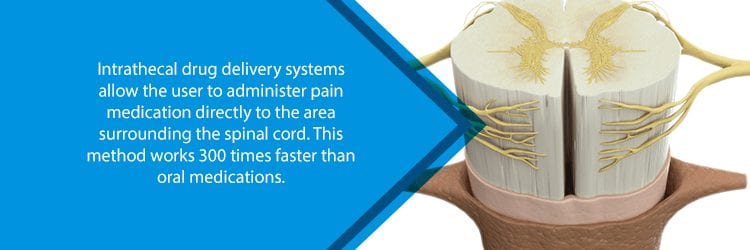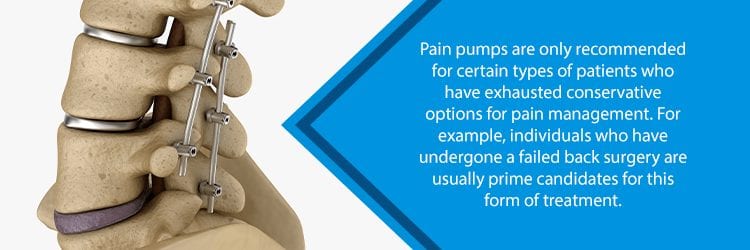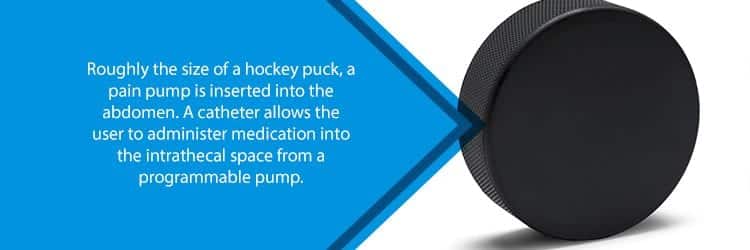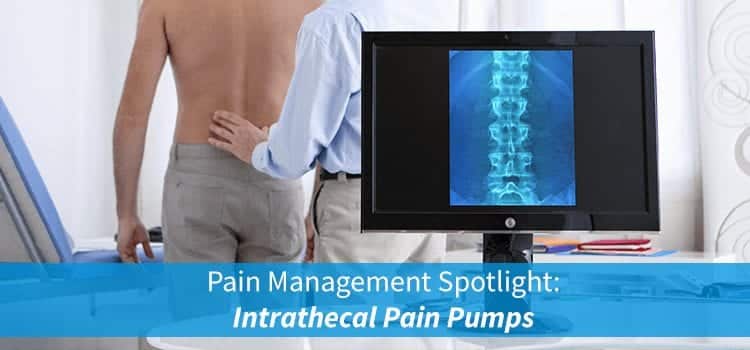As the name somewhat suggests, intrathecal pain pumps deliver medication directly into the spinal cord. Doctors accomplish this via a small pump that they place underneath the skin of the abdomen via minimally invasive spine surgery. This pump interacts with a catheter to deliver the medication to the area surrounding the patient’s spinal cord. The main advantage of this treatment is the simple fact that the medication is delivered directly to the affected area. Because of this, intrathecal pain pumps use less medication than other methods. By contrast, oral medications (specifically morphine and baclofen) require larger doses to effectively treat the patient’s condition.

What Is An Intrathecal Pain Pump?
The word “intrathecal” describes the space that surrounds the spinal cord. This is one part of the body where you can find cerebrospinal fluid. This is relevant because intrathecal pumps deliver medication directly into this fluid. Again, the main advantage of this over oral medication is the difference in necessary dosage. More specifically, oral medications take around 300 times longer for the body to process.
The pump itself is roughly the size of a hockey puck and is made of metal. The doctor places the device underneath the skin of the abdomen via a short surgical procedure. Next, the doctor connects the pump to a catheter (aka a tiny plastic tube). The medication travels from the pump through the catheter and into the intrathecal space. Inside of the pump itself, a reservoir holds the medication.
Programmers design intrathecal drug delivery systems to slowly release medication as time goes by. In fact, the nature of this feature allows the programmer to modify the device to suit the needs of the individual. In other words, you can adjust the settings on the pump. You can choose to release certain amounts of medication at various intervals throughout the day. Not only that, but the pump also stores your prescription data in its memory. This is very useful in certain situations, as it allows your doctor to review case-specific information with the device’s programmer.
In the event that the pump reservoir approaches empty, a medical professional will need to refill the pump. To do this, they use a small needle that they inject through the skin and into an opening on top of the reservoir.
Who Qualifies For An Intrathecal Pain Pump?
The answer to this will depend on the individual. To find out more information, make sure to communicate with your medical provider. Given your background and pre-existing conditions, he or she will be able to tell if pain pumps are right for alleviating your chronic back pain symptoms.
Doctors may consider Intrathecal pain pumps in patients when:
- Non-surgical treatment options have been exhausted
- Follow-up surgery does not provide the patient with any benefit
- There is a pain medication dependency in the patient
- No pre-existing psychological conditions have been detected
- The patient does not have a pre-existing medical condition that would otherwise compromise the procedure
- The patient has taken a trial medication that provided them with benefits
It’s important to remember that these are just general guidelines for patients who are viable candidates for this procedure. It is always important to discuss your options at length with your doctor.

What Conditions Do Intrathecal Pain Pumps Treat?
Typically, doctors use these devices to treat the following conditions:
- Cancer Pain: Cancer causes spinal tumors, which are painful if they put pressure on the spinal nerves. Additionally, scarring from radiation therapy is treatable via intrathecal pain pumps
- Failed Back Surgery Syndrome: This does not necessarily suggest an inadequately performed surgical procedure. Instead, it means exactly what it says. The surgery(s) the patient has undergone have not provided the patient with sufficient pain relief. As a result, the patient experiences chronic pain that conservative treatments cannot alleviate.
- Arachnoiditis: Protective layers known as the meninges coat the spinal nerves. When these protective layers become inflamed, they can lead to this painful condition.
- Chronic Pancreatitis: Sometimes, the pancreatic duct is blocked or inflamed. When this occurs, it causes chronic abdominal pain.
- Reflex Sympathetic Dystrophy: This disease worsens with time and affects the nervous system. It causes a feeling of constant, painful, burning sensations or nerve pain.
- Causalgia: Causes similar sensations to reflex sympathetic dystrophy. The difference is that this is caused by a peripheral nerve injury.
These are the main conditions that intrathecal pain pumps treat. That being said, this treatment is also known to reduce spasticity. Spasticity describes a combination of muscle rigidity and spasms, which affect the movement of the extremities. Spasticity is caused by conditions such as:
- Cerebral Palsy
- Multiple Sclerosis
- Brain & Spinal Cord Injuries
- Stroke
Intrathecal Pain Pump Surgery
There are two main parts of this procedure. Firstly, the performing doctor must place the catheter in the intrathecal space. Secondly, the doctor must place the pump and reservoir devices in the abdomen. Generally, this surgery takes anywhere from 3 to 4 hours.
To begin, the patient is placed on his or her side and given anesthesia. Usually, the incision points on the back and stomach are shaved and prepped for inserting the devices. Next, the surgeon makes a small incision in the thoracic back region. This serves as an access point for the catheter, which the surgeon then inserts into the intrathecal space and secures via sutures.
Once the catheter is in its proper place, the doctor attaches a catheter extension to the device, which passes under the skin from the spine. The catheter extension is wrapped around the torso to the abdomen, which is the where the pump is implanted.
To position the pump, the doctor will make a 4-6 inch incision in the side of the abdomen. Usually, this incision is made below the waistline. Next, the surgeon must create a pocket of space for the pump to sit in. The surgeon usually creates this space between the skin and muscle layers. Once the doctor has the pump in place, he or she will connect the catheter extension to the pump. To keep the pump in the proper place, the doctor sutures the device to the fascia layer coating the stomach muscles. At this point in the procedure, the surgeon closes all incisions with staples and applies wound dressings.

Do you have chronic neck or back pain? Contact Us.
Have you had back surgery in the past that has not alleviated your symptoms? Have you exhausted all conservative treatment options to no avail? If so, then intrathecal pain pumps may be right for you. To discuss your options, please contact us at (855) 586-2615. Our spine doctors in NJ take pride in using conservative and minimally invasive procedures to treat all patients. They will work tirelessly to put you on a treatment plan that satisfies the specific nature of your condition.

